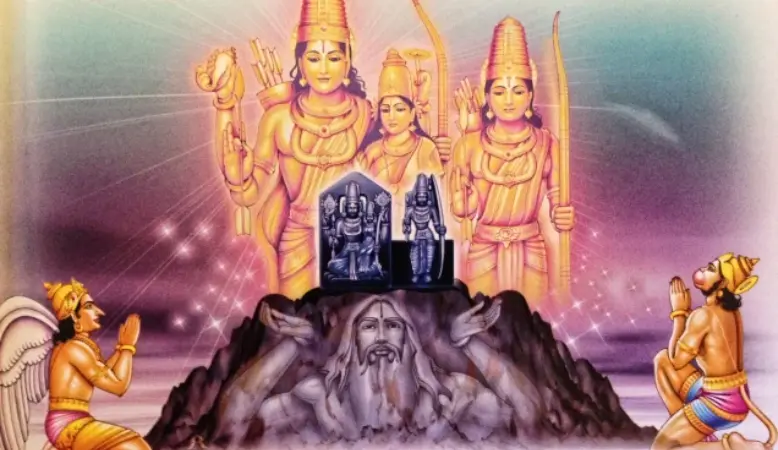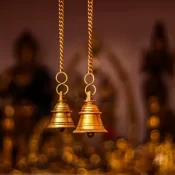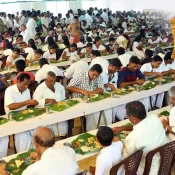The Enchanting Legacy and History of Sree Seetha Ramachandra Swamy Devasthanam, Bhadrachalam
Nestled amidst serene hills and embraced by the sacred Godavari River, Bhadrachalam is a revered shrine dedicated to Lord Rama, the seventh avatar of Vishnu. This hallowed site, set in the ancient Dandakaranya forest of the Ramayana era, is where Rama, along with his consort Sita and brother Lakshmana, once wandered during their exile. The area also holds the poignant memory of Sita’s abduction by Ravana, marking it as a place of profound spiritual significance.
The Incarnation and Devotion
The essence of Bhadrachalam is interwoven with a tale of divine promise and devotion. Sage Bhadra, an ardent devotee of Lord Rama, performed rigorous penance by the banks of the Godavari River, yearning for a glimpse of his deity. Despite Rama’s vow to fulfill Bhadra’s wish after completing his mission on Earth, the sage’s devotion was so profound that he continued his penance across Yugas, awaiting the fulfillment of the divine promise. In response to this unwavering devotion, Vishnu manifested Himself as Vaikunta Rama, arriving with Sita and Lakshmana, and revealed Himself in a manner reminiscent of the Gajendra Moksha episode. The hill where the deities were established became known as Bhadrachalam, with the divine presence of Rama, Sita, and Lakshmana commemorated through their sacred idols.
The Discovery and the Temple’s Creation
The divine idols of Vaikunta Rama, Lakshmana, and Sita were rediscovered in the 17th century by Pokala Dhammakka, a devout follower from Bhadrireddypalem. According to legend, she dreamt of Lord Rama instructing her to find and worship these idols. Following her vision, she unearthed them from an anthill, washed them with the holy water of the Godavari, and began daily worship. With the divine promise that a true devotee would one day build a temple, Dhammakka waited patiently for the right person.
Bhakta Ramadas
This devotee turned out to be Kancharla Gopanna, famously known as Bhakta Ramadas. Born in 1620, Gopanna was a devoted worshipper of Rama and the nephew of Akkanna, the administrative head in the court of Nawab Abul Hassan Shah, known as Taneshah of Golkonda. When he learned about the sacred site of Bhadrachalam, his curiosity was piqued, and he decided to visit. Upon arriving, he found the deities in a remarkable appearance. Ramadas then asked the villagers to contribute liberally to the construction of the temple. However, when the contributions proved insufficient, the villagers appealed to him to use the revenue collections for the temple’s construction, with a promise to repay the amount after the harvest. Accordingly, Ramadas constructed the temple using Rs. 6 lakhs from the land revenues without the permission of the Nizam Nawab.
As the temple neared completion, Gopanna encountered a significant obstacle in placing the Sudarshana Chakra atop the temple. In a dream, Lord Rama instructed him to bathe in the Godavari River, where the divine Chakra would appear. Following this divine guidance, Gopanna found the Chakra in the river and completed the temple.
Shortly after the temple’s construction, Gopanna faced severe hardships. He was dismissed from his official position due to the alleged misuse of funds for the temple’s construction and was imprisoned in Golkonda Fort for twelve years, enduring harsh treatment. In the depths of his suffering, Gopanna, known for his unwavering devotion, pleaded with Lord Rama for relief. He expressed his anguish and devotion through a series of heartfelt songs and hymns, which later became widely known as the ‘Dasaradhi Sathakam’ and the ‘Keertanas’ of Bhakta Ramadasa.
The Miracle and Redemption
During his imprisonment, Gopanna’s devotion and suffering came to the attention of Nawab Tanishah, the ruler of Golconda. Moved by Gopanna’s unwavering devotion, Tanishah discovered that Rama and Lakshmana had appeared to him in disguise to repay the funds used for the temple. Realizing the divine nature of the situation, the Nawab arranged for Gopanna’s release and honored him with a gesture of profound respect. This act was significant in fostering communal harmony and respect for devotion across faiths. The Nawab allocated income from the Palwoncha Paragana for the temple’s maintenance and continued the tradition of offering pearls during the annual Kalyana Mahotsavam. This practice remains a cherished tradition to this day.






